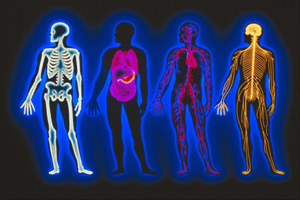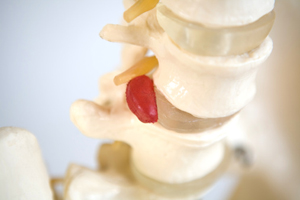The Chiropractic Vertebral Subluxation Complex
The nervous system, consisting of the brain, spinal cord and all the nerves of the body, controls and regulates your entire body. Everything from your nose to your toes.
 Your nervous system is so vital that it is protected by bone. The brain is protected by the skull, and 24 bones of the spinal column sheathe the spinal cord.
Your nervous system is so vital that it is protected by bone. The brain is protected by the skull, and 24 bones of the spinal column sheathe the spinal cord.
Stress can set off a chain reaction that affects the spinal bones, nerves, muscles, soft tissues and can produce degenerative changes to the body. Chiropractors refer to this as the Vertebral Subluxation Complex. Looking at each component of the subluxation complex make it simple to understand.
Subluxation Complex Component #1 Kinesiopathology
The bones of the spine are designed to move, while protecting the spinal cord and nerve roots. But stress can cause one or more vertebra to become “stuck” or fixated. This can produce compensation reactions in which other joints become hypermobile, moving too much.
These problems can compromise the essential spinal curves and interfere with your ability to turn and bend.
Chiropractors detect this aspect of the Vertebral Subluxation Complex by evaluating your posture, using X-rays, assessing your gait, and by using other orthopedic tests.
Subluxation Complex Component #2 Neuropathophysiology
When the bones protecting your spine dont move properly, delicate nerve tissue can be affected. Nerves can become pinched or irritated.
The pinched nerve, which is commonly associated with the spine, is actually quite rare. Some assert that only 10% to 15% of spinal-related problems are caused by direct pressure of bone on nerve tissue!
More frequently, nerves are irritated by the improper functioning of adjacent spinal structures. This can cause nerve tissue to become stretched, twisted, or inflamed by malfunctioning spinal bones.
Nervous system impairment can affect communications between the brain and the body, increasing the susceptibility of disease and ill health and impairing ones ability to self heal.
Subluxation Complex Component #3 Myopathology
Since bones are static structures that only move when acted upon by muscles, the supporting muscles of the spine are involved in the subluxation complex.
When nerve impulses are constrained, muscles supporting the spine can weaken and atrophy. The reverse can occur from over stimulation and muscles can become tight and go into spasm.
In either case, fibrotic scar tissue can change the elasticity of affected muscles. This is often why repeated adjustments are necessary to make lasting spinal changes. It also explains why long-standing spinal problems take longer to rehabilitate than relatively newer injuries.
Subluxation Complex Component #4 Histopathology
 Discs, ligaments and other connective tissues can be affected, too. And while the intervertebral disc cant technically slip, it can tear, bulge, herniate and degenerate.
Discs, ligaments and other connective tissues can be affected, too. And while the intervertebral disc cant technically slip, it can tear, bulge, herniate and degenerate.
Ligaments and other connective tissues are often involved. Inflammation, edema and swelling are often accompanied by an accumulation of blood and lymph, rise in temperature and tenderness to the touch.
Discs and ligaments are known to have a poor blood supply. This can make the healing of soft tissues a time-consuming process.
Subluxation Complex Component #5 Pathophysiology
One of the ways the body responds to malfunction or trauma to a joint is by stabilizing the area by slowly depositing calcium, much like the process of mending a broken bone.
With time, calcium builds up, eventually causing bone spurs and other abnormal bony growths. This arthritic “splinting” of adjacent bones can turn a once mobile joint into a solid block of calcium in a series of stages or phases.
Phase One: Loss of spinal curve and reduced range of motion
Phase Two: Disc narrowing, lipping and bone spur formation
Phase Three: Joint immobilization and, eventually, bone fusion
Depending upon the phase, regular chiropractic care is hoped to slow or stop this degenerative process.
The Vertebral Subluxation Complex Simplified
The vertebral subluxation and its complex associated pathologies, are the unique domain of chiropractors. The subluxation complex and its far-reaching effects continue to interest researchers who want to better understand its role in immune system response, aging, hormonal involvement and gene expression.